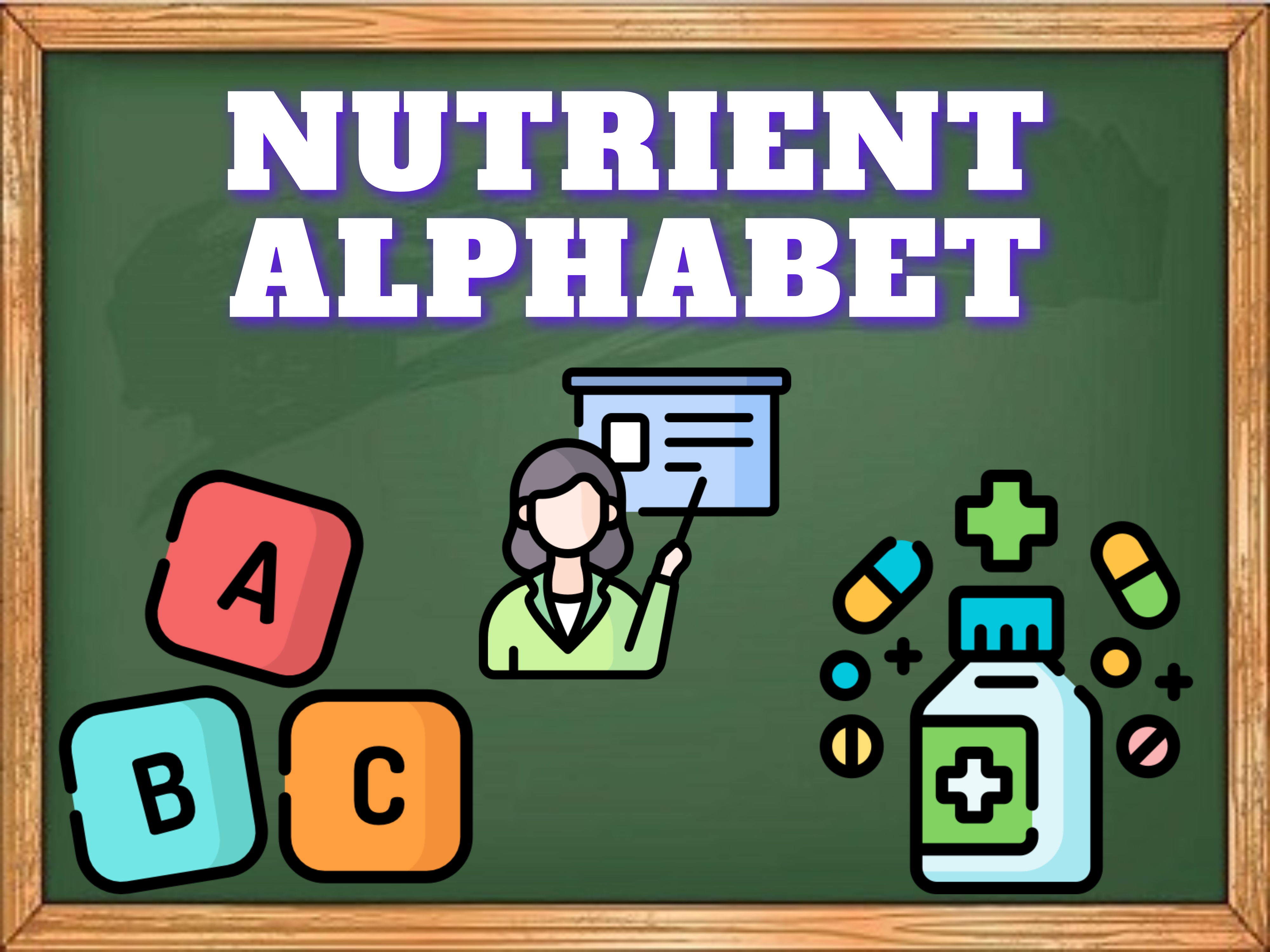
Introduction
Everyone knows their ABCs, right? Well, I'm calling this list the ABCs of Nutrients. Letter by letter, we'll be going down the alphabet, listing an important nutrient for each letter. You can also check out a similar post of mine called The ABCs of Food, where I discussed 3 different foods per letter of the alphabet. This may be an odd way to get your kids to learn the alphabet...


Alphabet

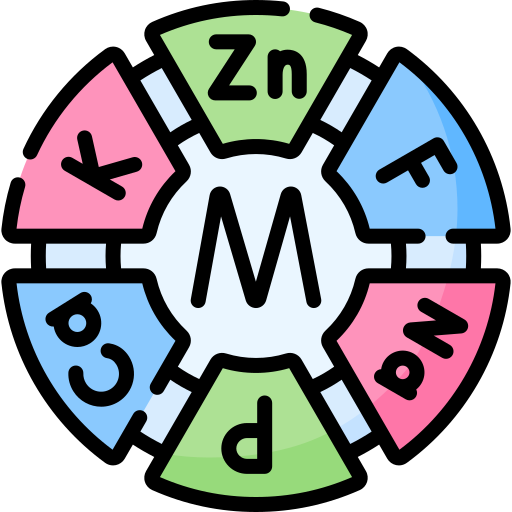
A is for Vitamin A
Description
Vitamin A is an essential fat soluble vitamin found predominantly in orange foods. It's main function is for eye health, which is why carrots are good for your vision. Provitamin A (like beta-carotene) is the precursor to Vitamin A, meaning that the body converts beta-carotene into vitamin A. The RDA (Recommended Dietary Allowance) for Vitamin A is 900 mcg, and a deficiency can lead to vision problems and a weakened immune system.
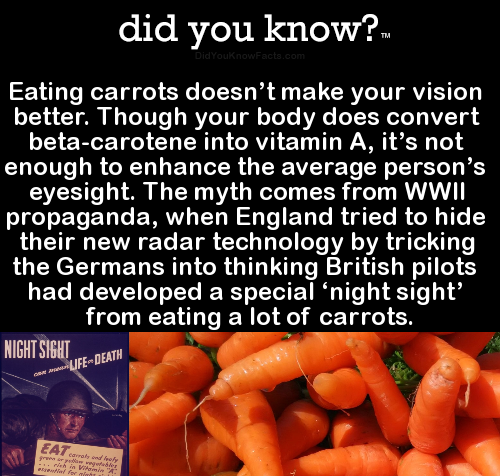
Benefits
Sources (per 100 g)
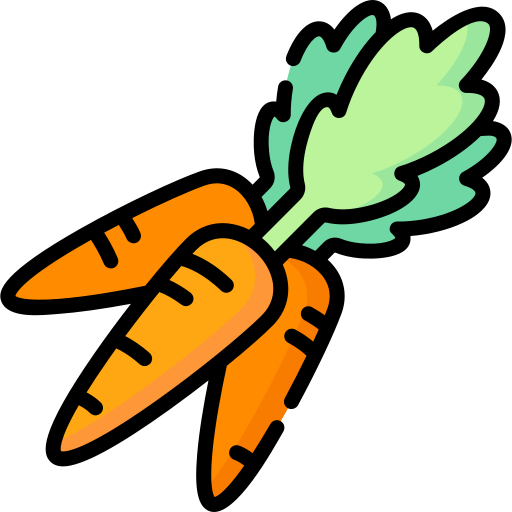

B is for Vitamin B12 (Cobalamin)
Description
Vitamin B12 (Colbalamin) is an essential water soluble vitamin found preominantly in animal source foods, like meat, dairy, eggs, and fish. It plays a large role in energy production, as B12 helps your body convert food into glucose, which is why many vegans or people deficient in vitamin B12 may have low energy. It is also important for brain, nervous system, heart, and bone health. The RDA is 2.4 mcg.
Benefits
Sources (per 100 g)
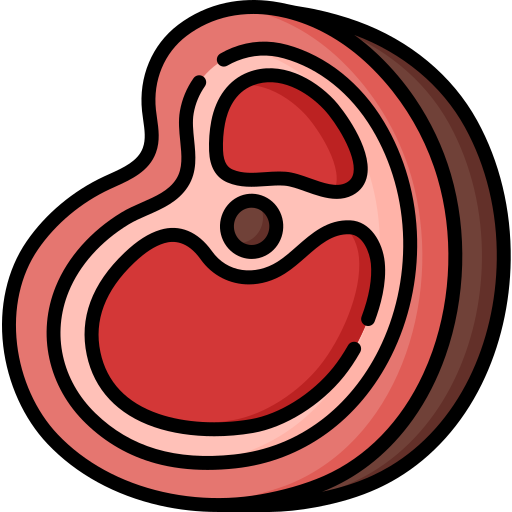

C is for Vitamin C
Description
Surprisingly, C is not for carbs. I already have a more in depth post about carbohydrates; see Carbs: The Devil in Disguise?.
Vitamin C is an essential water soluble vitamin found main in citrus fruits and leafy vegetables. It is a powerful antioxidant, and plays an important role in immune system health. I'm sure you've all heard the myths about taking vitamin C or drinking orange juice to ward off a cold. Vitamin C is also important for the absorption of iron in the body. A deficiency in vitamin C can lead to scurvy, poor skin health, and poor immune health. The recommended daily intake of vitamin C is 90 mg.
Benefits
Sources (per 100 g)


D is for Vitamin D
Description
Vitamin D is an essential fat soluble vitamin that's pretty hard to come by from food. There are some foods that contain vitamin D like eggs and fish (and milk is often fortified with it), but the main source of vitamin D is from sunlight. As the main source is from the sun, many people become low in vitamin D in the winter, which increases the risk of bone disorders, fractures, immune disfunction, and poor mood. The RDA of vitamin D is 20 mcg.
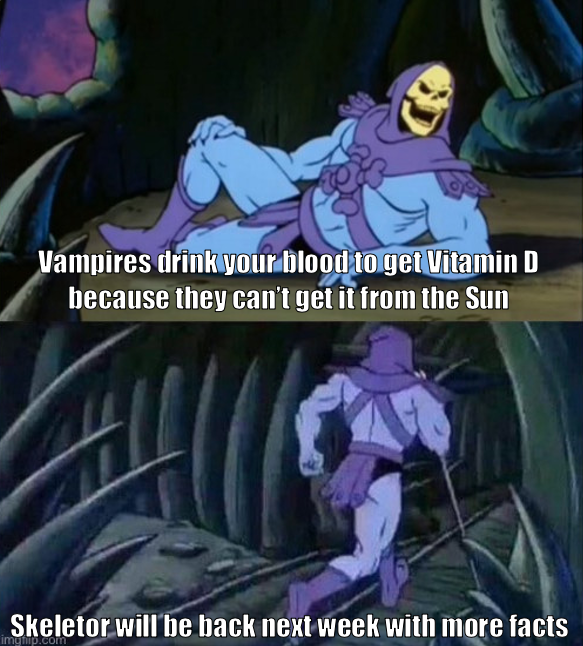
Benefits
Sources (per 100 g)
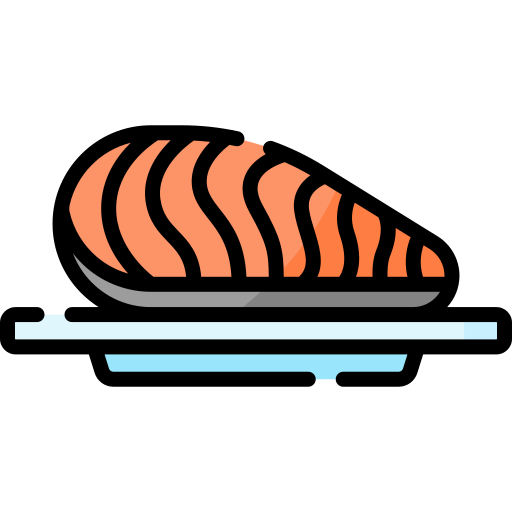

E is for Vitamin E
Description
Vitamin E is an essential fat soluble vitamin found in nuts, seeds, and leafy vegetables. It is a powerful antioxidant, and plays an important role in skin, heart, and eye health, as well as regulating hormones. The recommended intake is 15 mg, and a deficiency can lead to neurological problems and a weakened immune system.
Benefits
Sources (per 100 g)
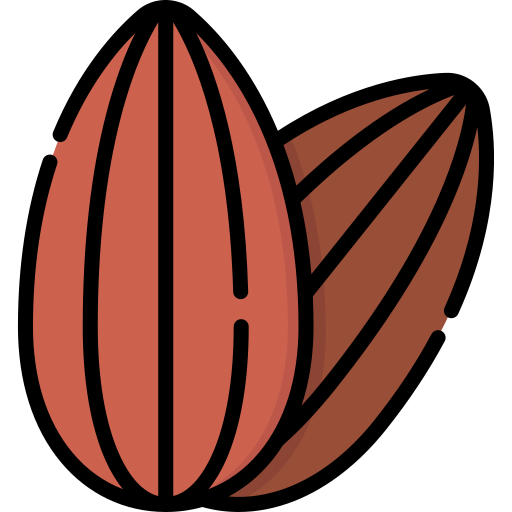

F is for Folate (Vitamin B9)
Description
Surprisingly, F is not for fat, and it's not for fiber either. I already have a more in depth posts about these nutrients; see Fat: The Innocent Criminal? and Fiber: Happiness is a Good Poop.
Folate, or vitamin B9, is a water soluble vitamin found in many plant-based foods, lik nuts, seeds, beans, and leafy vegetables. Folate is critical for the growth of cells and development of fetuses. It also aids in the formation of red blood cells, lowers your risk for depression, and lowers levels of homocysteine in the blood. A folate deficiency can lead to cognitive issues, anemia, and pregnancy defects. The RDA for folate is 400 mcg.

Benefits
Sources
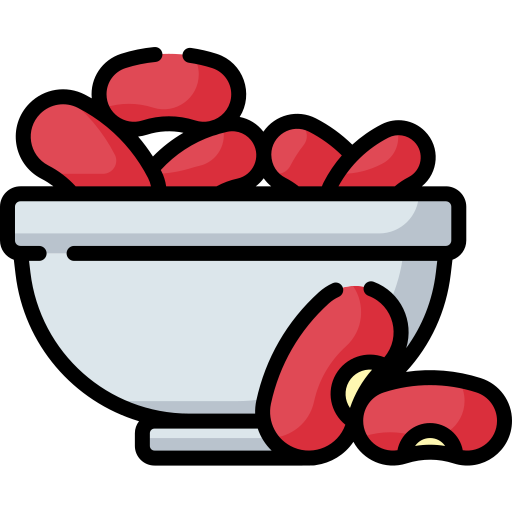
.png)
G is for Glucose
Description
Glucose is the energy of life. It's a simple sugar that your cells use for energy. Foods that you eat get broken down into glucose and stored as glycogen in the liver to be used for energy later. Additionally, glucose is broken down in your cells, where the mitochondria produce adenosine triphosphate (ATP), or energy for cellular function. Glucose is found anywhere you find carbs in your diet, and makes up 50% of table sugar (sucrose, the bond between glucose and fructose).
An excess of glucose is stored as fat though, leading to weight gain. Most people consume and store too much glucose (70% of the US population is overweight or obese), but that doesn't inherently make glucose bad for you; just bad in excess. Depleting the glycogen stores in your liver is what people mean when they say they're "hitting the wall" in a workout, which is much more likely to happen to those on a low carb diet.
Benefits
Sources

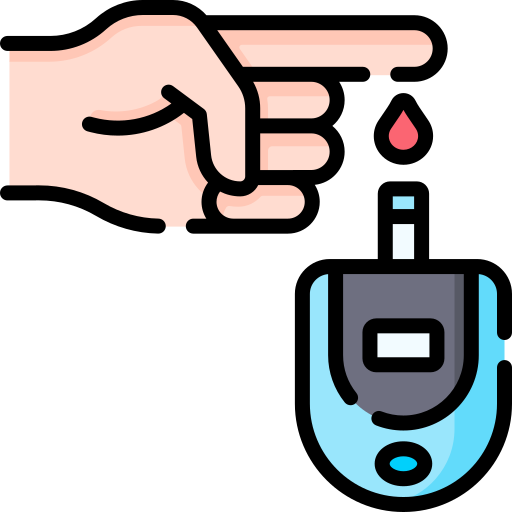
H is for Histidine
Description
Histidine is one the 9 essential amino acids. It is a building block for protein, and is a precursor to histamine. Histamine plays a role in immune response, stomach acid production, and regulating sleep cycles. Histidine is also important for pH regulation and hemoglobin formation. The RDA of histidine is 1.14 g, and is mainly found in complete proteins and other high protein foods.
To read more about protein and essential amino acids, see Protein: The Essential Building Blocks. The other 8 essential amino acids are the following:
Benefits
Sources (per 100 g)


I is for Iodine
Description
Surprisingly, I is not for iron. I already have a more in depth post about iron; see I Run on Iron.
Iodine is a nutrient that's main purpose is for thyroid function. It is essential for the synthesis of thyroid hormoes T4 (thyroxine) and T3 (triiodothyronine), aiding in energy production, growth and development, and metabolism regulation. Foods from the sea (like fish and kelp) are naturally high sources of iodine, but typically salt is fortified with iodine. The recommended daily intake of iodine is 150 mcg, the amount in about half a teaspoon of iodized salt.
Benefits
Sources (per 100 g)
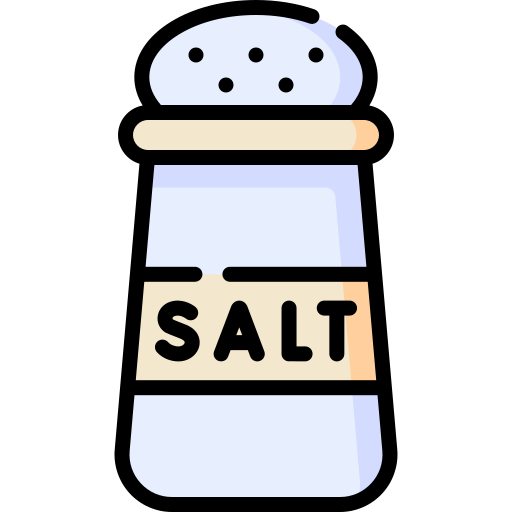
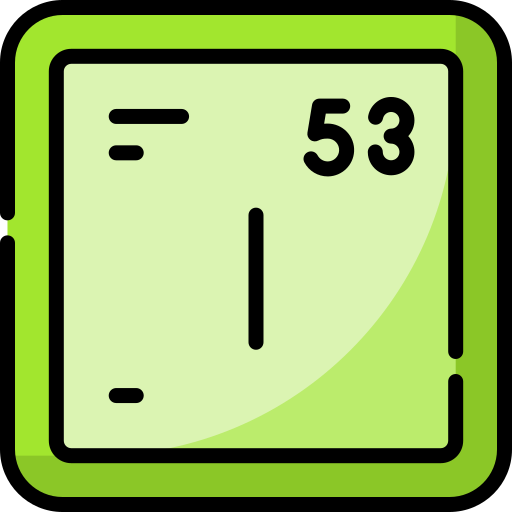
J is for Joule
Description
J is a hard letter; this is the best I could come up with. A joule (J) is a unit of energy, just like a calorie. 1 kCal is equal to 4.184 kJ (kilojoules).
1 cal (not kCal) is the energy required to raise the temperature of 1 gram of water by 1 degree Celcius. What we conventionally refer to as a "calorie" (cal) is actually a kilocalorie (kCal), or 1000 calories.

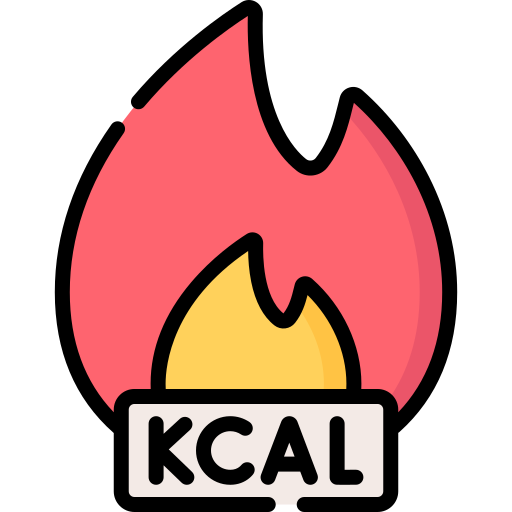
K is for Vitamin K
Description
Vitamin K is an essential fat soluble vitamin that is mainly found in dark leafy greens. It is important in bone and heart health, as well as cell growth. Vitamin K also aids in the synthesis of protein for blood coagulation, which prevents excessive bleeding during injuries. Those on blood thinners should pay attention to their intake of vitamin K. Deficiencies in vitamin K can lead to easy bruising, excessive bleeding, and weak bones. The RDA of vitamin K is about 120 mcg.
Benefits
Sources (per 100 g)

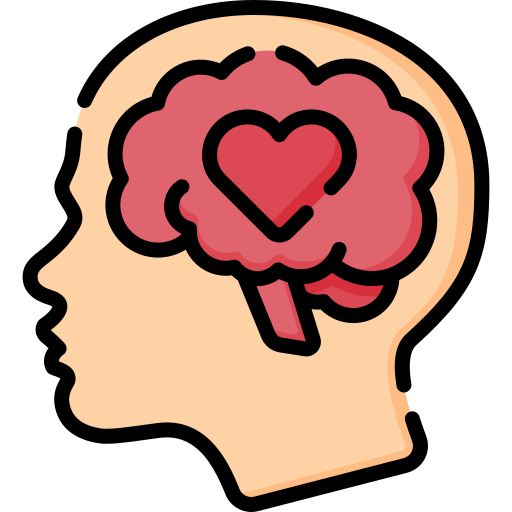
L is for Lycopene
Description
Lycopene is an antioxidant that aids in heart and eye health, as well as skin protection and cancer prevention. Tomatoes are typically though of as the richest source of lycopene, but it is also very high in watermelon as well. Lycopene is fat soluble, so like with the fat soluble vitamins (A, E, and K), it's best to consume it with a bit of fat for maximum effectiveness. There is no recommended daily intake of lycopene, as it's not considered an essential nutrient, but it can provide critical health benefits.
Benefits
Sources (per 100 g)
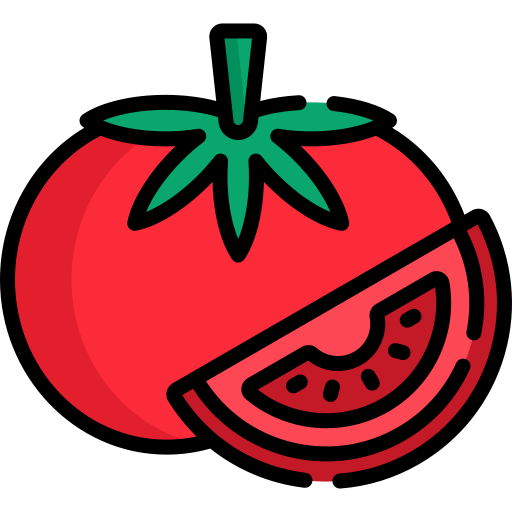
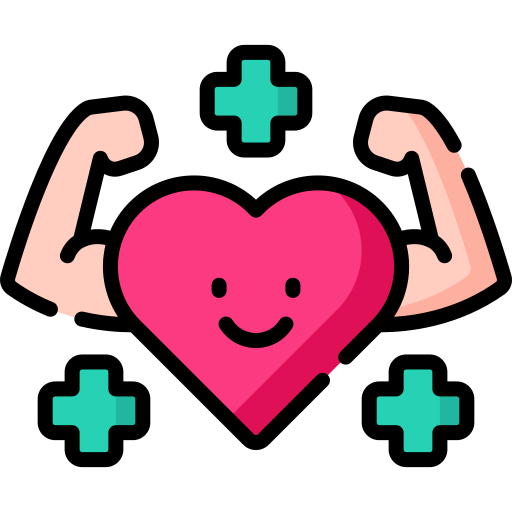
M is for Manganese
If you're wondering why M is not for Magnesium, then you should check out my dedicated post about magnesium: Mag-nificent: The Mighty Mineral for Muscles and Mind.
Manganese is a trace mineral essential for bone formation, nutrient metabolism, and antioxidant defense. It is commonly found in whole grains, nuts, legumes, leafy greens, and teas. Manganese plays a vital role in forming connective tissue, bones, blood-clotting factors, and sex hormones. It also contributes to wound healing, nerve function, and the metabolism of carbohydrates and fats. The adequate intake (AI) for manganese is 2.3 mg per day for adult men and 1.8 mg for women. Deficiency is rare but may lead to poor bone growth, reproductive issues, and impaired glucose and lipid metabolism.
Benefits
Sources (per 100 g)
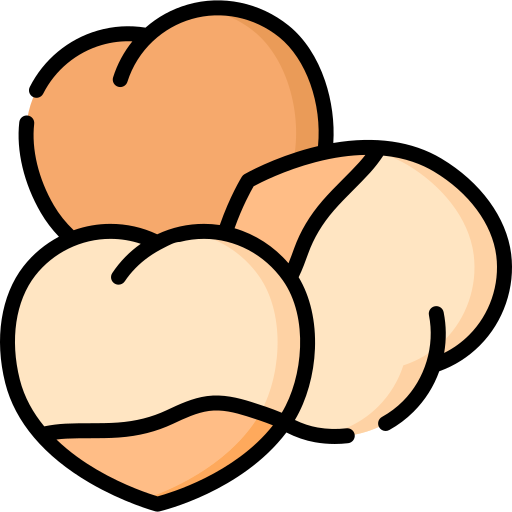
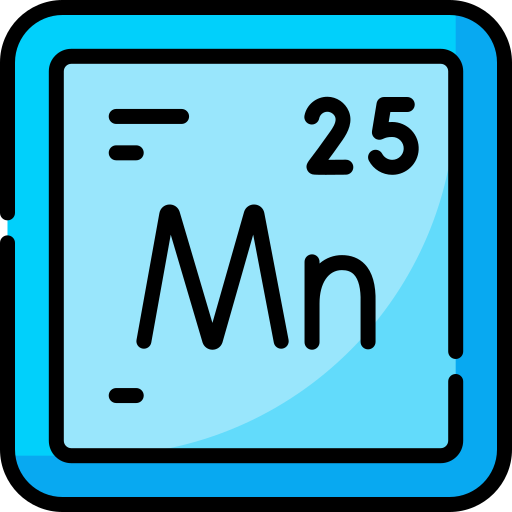
N is for Niacin (Vitamin B3)
Description
Niacin, or vitamin B3, is a water soluble vitamin rich in meat, fish, nuts, and seeds. It is important in managing cholesterol, increasing HDL and decreasing LDL. It also benefits the the skin, nervous system, and digestion, as well as aiding in the metabolism of glucose. A deficiency in niacin can lead to pellagra, which has symptoms of diarrhea, dermatisis, and dementia. The recommended intake of niacin is at least 16 mg per day.

Benefits
Sources (per 100 g)
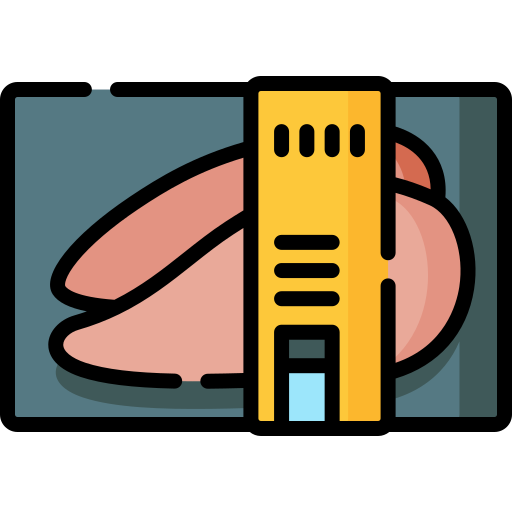

O is for Omega-3s
Description
Omega-3's are a type of essential fatty acid that is typically underconsumed in the standard American diet (SAD). Proper intake of omega-3 fats have been shown to benefit cardiovascular and brain health, as well as improve mood. It is anti-inflammatory unlike Omega-6 fatty acids, which are present in vegetable oils.
There are 3 types of omega-3 fatty acids: Alpha-linolenic Acid (ALA), Eicosapentaenoic Acid (EPA), and Docosahexaenoic Acid (DHA). EPA and DHA are the bset sources of omega-3 fats, and are found in fish and algae. ALA on the other hand has to be converted into EPA and DHA in the body at only about a 5% rate, making it much less bioavailable. Sources of ALA are nuts like walnuts and macadamia nuts, and seeds like chia, flax, and hemp. As seafood is a much better source of omega-3 fats, the American Heart Associate (AHA) recommends eating about 2 servings of fatty fish per week.
Benefits
Sources (per 100 g)


P is for Phosphorus
Description
Surprisingly, P is not for protein. I already have a more in depth post about protein; see Protein: The Essential Building Blocks It's also not for potassium either; check out A Monkey Never Cramps: Why You Need Potassium.
Phosphorus might not get as much attention as calcium, but it’s just as essential for building strong bones and teeth. In fact, about 85% of the phosphorus in your body is found in your skeleton. While it's present in meat and dairy, you can also find it in plant foods like lentils, seeds, and nuts. Phosphorus helps your body create ATP, the molecule your cells use for energy. It also supports the repair of cells and tissues. The recommended daily intake is around 700 mg, regardless of gender.A deficiency (though rare) may cause weak muscles, bone pain, fatigue, and irregular breathing.
Benefits
Sources (per 100 g)
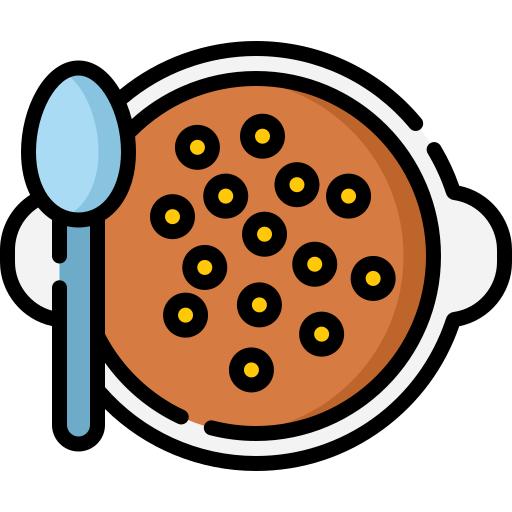
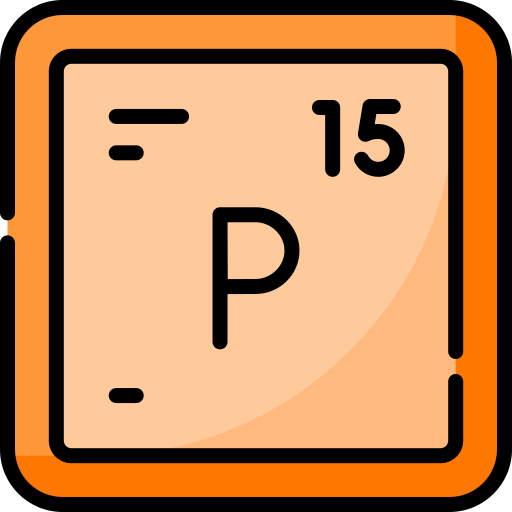
Q is for Quercetin
Description
Quercetin is a flavanol found predominantly in colorful fruits and vegetables. It is an important antioxidant, reducing oxidative stress and preventing chronic disease. Quercetin has also been shown to regulate blood sugar levels, improve insulin sensitivity, and benefit brain health. The daily intake of quercetin is not established, but estimates are about 100 mg per day.
Benefits
Sources (per 100 g)
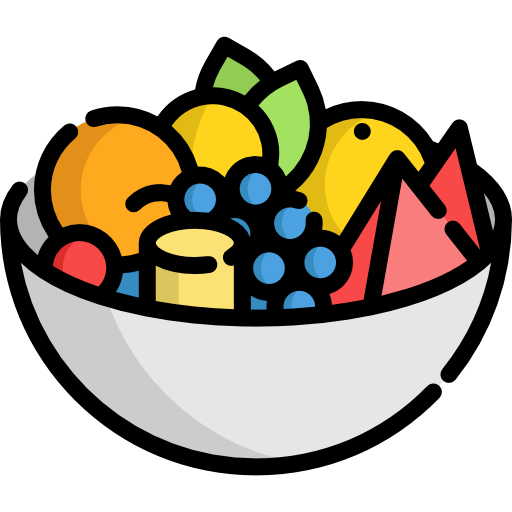
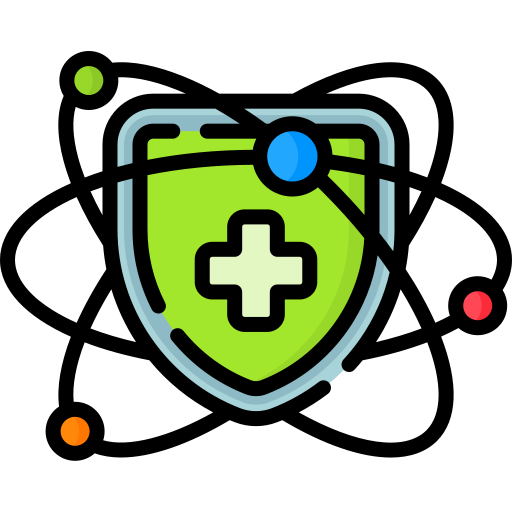
R is for Riboflavin (Vitamin B2)
Description
Riboflavin, or vitamin B2, is a water soluble vitamin found in meat, fish, dairy, eggs, nuts, seeds, and leafy vegetables. It plays a vital role in the production of ATP and red blood cells, promoting proper nervous system function and and maintaining healthy eyes and skin. Daily intake amount for riboflavin is set at about 1.3 mg.
Benefits
Sources (per 100 g)
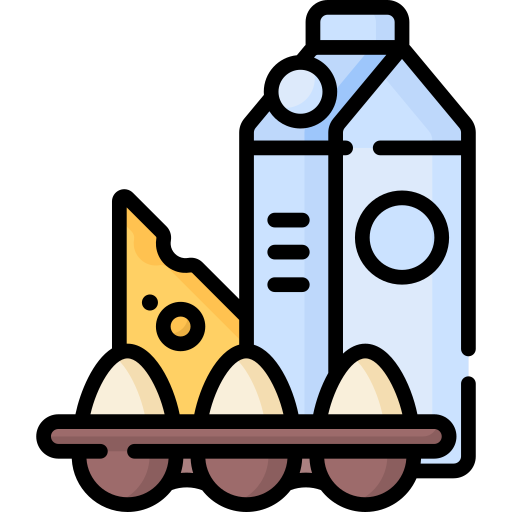

S is for Selenium
Description
Brazil nuts, I mean selenium, is an essential mineral that's important for proper cognitive and thyroid function, as well as helping to prevent against cancer and Alzheimer's. The RDA of selenium is 55 mcg, about the amount found in less than a single Brazil nut. Selenium is essential and important to consume, but toxicity can occur if intake is too high, over 400 mcg per day. It's recommended to not consume more than 5 Brazil nuts per day. Other rich sources of selenium are meat, fish, nuts, and seeds.
Benefits
Sources (per 100 g)
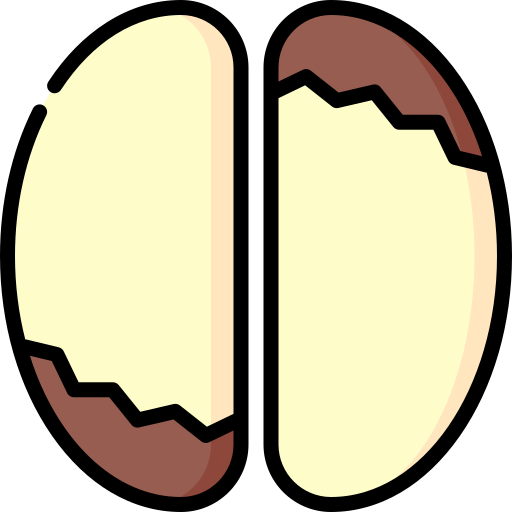
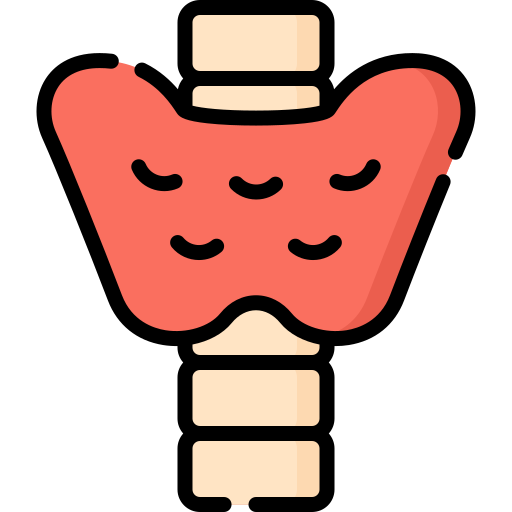
T is for Thiamin (Vitamin B1)
Description
Thiamin, or vitamin B1, is a water soluble vitamin that is mainly found in nuts and seeds. It is important in the production of ATP, as well as benefitting cognitive and nervous system function. A deficiency in thiamin can lead to Wernicke-Korsakoff Syndrome, a neurological condition leading to memory problems and other cognitive disfunction. 1.2 mg per day is the recommended intake.

Benefits
Sources (per 100 g)
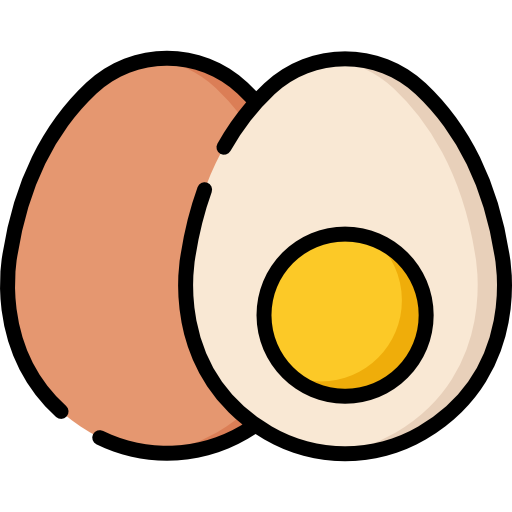
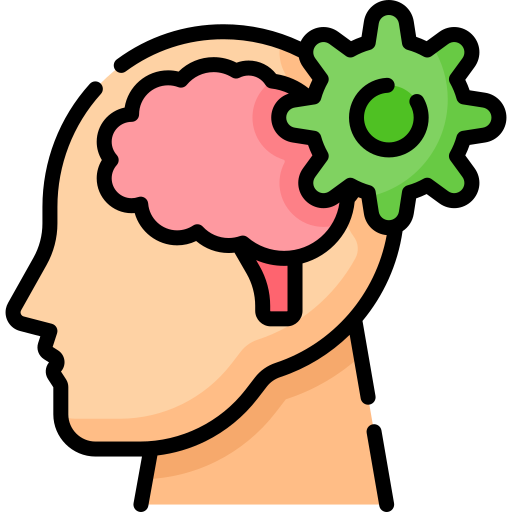
U is for Ubiquinone (CoQ10)
Description
Ubiquinone, also known as Coenzyme Q10 (or CoQ10 for short) is a naturally occuring biochemical cofactor and antioxidant produced in the body, but also found in foods like fish and meat. CoQ10 may support proper cellular and heart health, as well as neutralizing free radicals and reducing oxidative stress. Use of statins (cholesterol lowering medication) can reduce the body's natural level of CoQ10, so supplementation may be required to alleviate muscle pain and headaches. While there is no established intake, estimates are to consume at least 30 mg of CoQ10 per day.

Benefits
Sources (per 100 g)
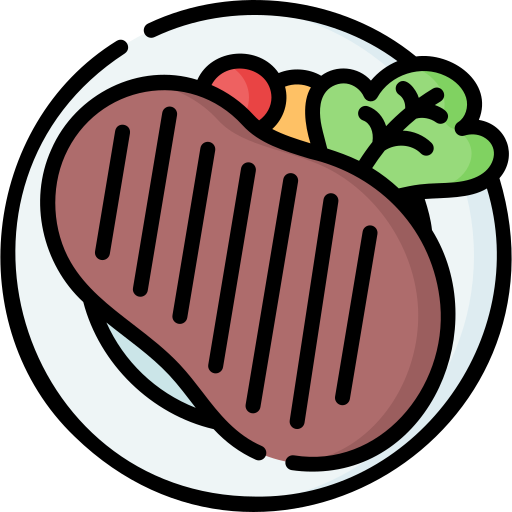
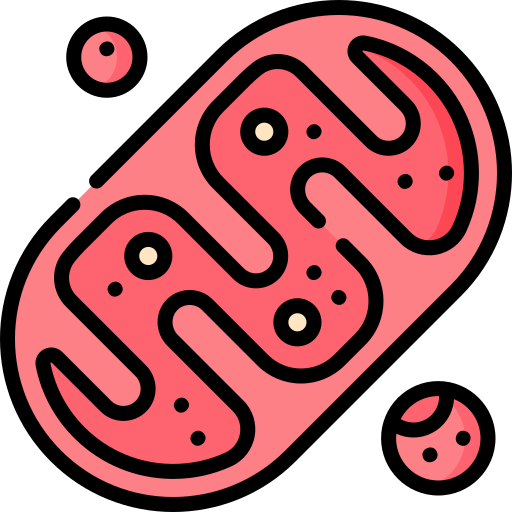
V is for Valine
Valine is one the 9 essential amino acids. It is a branched-chain amino acid (BCAA) that is important for tissue repair and muscle metabolism. Deficiencies may lead to impaired immune system, poor exercise performance and recovery, and muscle fatigue and weakness. The RDA of valine is 1.96 g, and is mainly found in complete proteins and other high protein foods.
To read more about protein and essential amino acids, see Protein: The Essential Building Blocks. The other 8 essential amino acids are the following:
Benefits
Muscle growth and repair
Energy production
Immune function
Mental focus
Nitrogen balance
Sources (per 100 g)
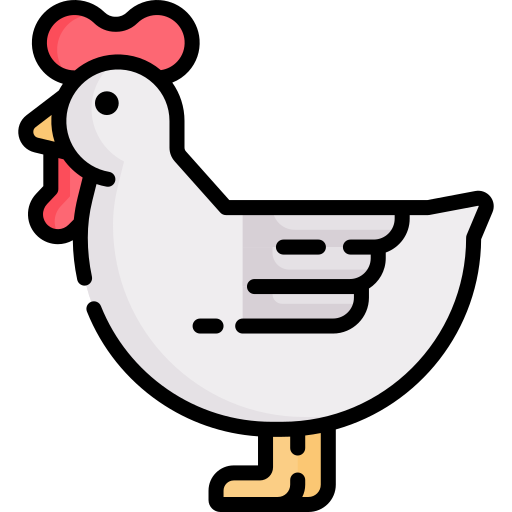

W is for Water
Description
Here's something you've probably never heard of: water. This "boring" liquid that we take for granted is about the single most important thing you can consume. Obviously it helps with hydration, but proper consumption of water also aids in transportation of nutrients, preventing muscle cramps, detoxification, skin health, weight management, and improved exercise performance. When dehydrated, you can experience headaches, fatigue, lightheadedness, and mood changes. Make sure to consume at least 8-10 cups (64-80 fl oz) of water a day, if not more.

Benefits
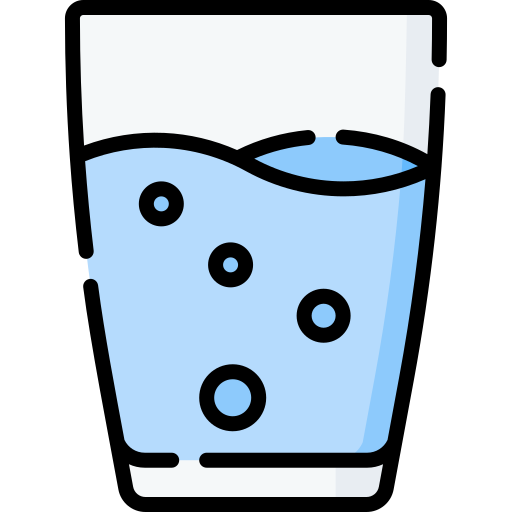

X is for Xanthophyll
Description
Xanthophyll is a carotenoid aiding in eye health, though it cannot be converted into vitamin A. Still, it is important to consume, aiding in the protection against UV radation, reducing inflammation, and improving cogitive performance. The most common carotenoids are lutein and zeaxanthin, and are mainly found in dark leafy greens. The recommended daily consumption of lutein and zeaxanthin are 10 mg and 2 mg, respectively.
Benefits
Sources (per 100 g)
.png)
.png)
Y is for Ylang-ylang
Description
Y is another hard letter to come up with something, so I went with ylang-ylang, a tropical flower that's used as an essential oil. It can help in improving your hair and skin health, enhancing your mood, and making you feel more relaxed and less stressed. It may also regulate blood pressure, relieve pain, and assist in sleep. If you have ylang-ylang essential oil, you can diffuse it into a room or put a few drops into a bath.
Benefits
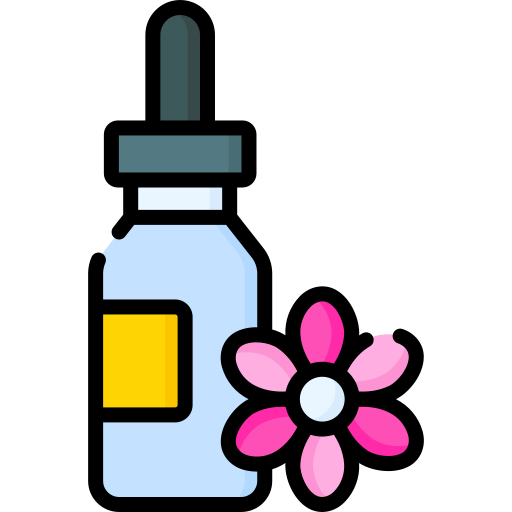

Z is for Zinc
Description
Finally, we have arrived at Z. Zinc is an essential mineral found in meat, fish, nuts, seeds, and cocoa. It supports a well functioning immune system, the synthesis of DNA and proteins, and optimal cognitive function. Low intake of zinc can impair taste and smell, as well as also cause textural issues in people. The recommended consumption is 11 mg per day.

Benefits
Sources (per 100 g)
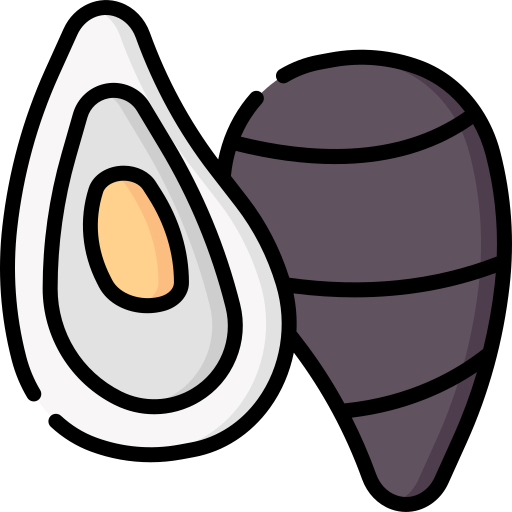
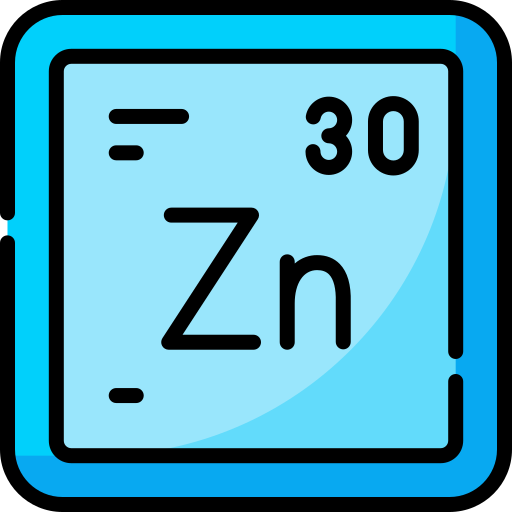
References
Everyone knows their ABCs, right? Well, I'm calling this list the ABCs of Nutrients. Letter by letter, we'll be going down the alphabet, listing an important nutrient for each letter. You can also check out a similar post of mine called The ABCs of Food, where I discussed 3 different foods per letter of the alphabet. This may be an odd way to get your kids to learn the alphabet...


Alphabet
- A is for Vitamin A
- B is for Vitamin B12 (Cobalamin)
- C is for Vitamin C
- D is for Vitamin D
- E is for Vitamin E
- F is for Folate (Vitamin B9)
- G is for Glucose
- H is for Histidine
- I is for Iodine
- J is for Joule
- K is for Vitamin K
- L is for Lycopene
- M is for Manganese
- N is for Niacin (Vitamin B3)
- O is for Omega-3s
- P is for Phosphorus
- Q is for Quercetin
- R is for Riboflavin (Vitamin B2)
- S is for Selenium
- T is for Thiamin (Vitamin B1)
- U is for Ubiquinone (CoQ10)
- V is for Valine
- W is for Water
- X is for Xanthophyll
- Y is for Ylang-ylang
- Z is for Zinc


A is for Vitamin A
Description
Vitamin A is an essential fat soluble vitamin found predominantly in orange foods. It's main function is for eye health, which is why carrots are good for your vision. Provitamin A (like beta-carotene) is the precursor to Vitamin A, meaning that the body converts beta-carotene into vitamin A. The RDA (Recommended Dietary Allowance) for Vitamin A is 900 mcg, and a deficiency can lead to vision problems and a weakened immune system.

Benefits
- Vision health
- Immune function
- Skin health
- Growth and development
- Reproductive health
Sources (per 100 g)
- Beef liver :: 4968 mcg (552 %)
- Bell peppers :: 157 mcg (17 %)
- Butternut squash :: 532 mcg (59 %)
- Cantaloupe :: 169 mcg (19 %)
- Carrots :: 835 mcg (93 %)
- Collard greens :: 251 mcg (28 %)
- Eggs :: 180 mcg (20 %)
- Kale :: 241 mcg (27 %)
- Pumpkin :: 426 mcg (47 %)
- Spinach :: 469 mcg (52 %)
- Sweet potatoes :: 709 mcg (79 %)
- Swiss chard :: 306 mcg (34 %)


B is for Vitamin B12 (Cobalamin)
Description
Vitamin B12 (Colbalamin) is an essential water soluble vitamin found preominantly in animal source foods, like meat, dairy, eggs, and fish. It plays a large role in energy production, as B12 helps your body convert food into glucose, which is why many vegans or people deficient in vitamin B12 may have low energy. It is also important for brain, nervous system, heart, and bone health. The RDA is 2.4 mcg.
Benefits
- Energy production
- Red blood cell formation
- Nervous system health
- Brain function
- DNA synthesis
- Heart health
Sources (per 100 g)
- Beef liver :: 59.3 mcg (2471 %)
- Chicken breast (boneless, skinless) :: 0.21 mcg (9 %)
- Chicken thighs (boneless, skinless) :: 0.61 mcg (25 %)
- Clams :: 12.69 mcg (529 %)
- Cod :: 0.91 mcg (38 %)
- Cottage cheese (nonfat) :: 0.46 mcg (19 %)
- Eggs :: 1.02 mcg (42 %)
- Greek yogurt (plain, nonfat) :: 0.75 mcg (31 %)
- Ground beef (93/7) :: 2.23 mcg (93 %)
- Ground turkey (93/7) :: 1.2 mcg (50 %)
- Halibut :: 1.1 mcg (46 %)
- Mackerel :: 6.94 mcg (289 %)
- Milk (skim) :: 0.5 mcg (21 %)
- Oysters :: 8.75 mcg (365 %)
- Salmon :: 4.15 mcg (173 %)
- Sardines :: 8.94 mcg (372 %)
- Tuna :: 2.55 mcg (106 %)


C is for Vitamin C
Description
Surprisingly, C is not for carbs. I already have a more in depth post about carbohydrates; see Carbs: The Devil in Disguise?.
Vitamin C is an essential water soluble vitamin found main in citrus fruits and leafy vegetables. It is a powerful antioxidant, and plays an important role in immune system health. I'm sure you've all heard the myths about taking vitamin C or drinking orange juice to ward off a cold. Vitamin C is also important for the absorption of iron in the body. A deficiency in vitamin C can lead to scurvy, poor skin health, and poor immune health. The recommended daily intake of vitamin C is 90 mg.
Benefits
- Antioxidant properties
- Collagen production
- Immune function
- Absorption of iron
- Heart Health
- Anti-inflammatory effects
Sources (per 100 g)
- Bell peppers :: 127.7 mg (142 %)
- Broccoli :: 89.2 mg (99 %)
- Brussel sprouts :: 85.0 mg (94 %)
- Cabbage :: 36.6 mg (41 %)
- Cauliflower :: 48.2 mg (54 %)
- Collard greens :: 35.3 mg (39 %)
- Grapefruit :: 31.2 mg (35 %)
- Guava :: 228 mg (254 %)
- Kale :: 93.4 mg (104 %)
- Kiwi :: 92.7 mg (103 %)
- Oranges :: 59.1 mg (66 %)
- Papaya :: 60.9 mg (68 %)
- Peas :: 40.0 mg (44 %)
- Potatoes :: 19.7 mg (22 %)
- Strawberries :: 58.8 mg (65 %)
- Swiss chard :: 30.0 mg (33 %)
- Tomato paste :: 21.9 mg (24 %)
- Tomatoes :: 27.2 mg (30 %)
- Yellow squash :: 19.3 mg (21 %)
- Zucchini :: 17.9 mg (20 %)


D is for Vitamin D
Description
Vitamin D is an essential fat soluble vitamin that's pretty hard to come by from food. There are some foods that contain vitamin D like eggs and fish (and milk is often fortified with it), but the main source of vitamin D is from sunlight. As the main source is from the sun, many people become low in vitamin D in the winter, which increases the risk of bone disorders, fractures, immune disfunction, and poor mood. The RDA of vitamin D is 20 mcg.

Benefits
- Bone health
- Immune function
- Muscle function
- Heart health
- Mood regulation
- Cancer prevention
Sources (per 100 g)
- Eggs :: 2.5 mcg (12 %)
- Halibut :: 4.7 mcg (24 %)
- Milk (skim) :: 1.2 mcg (6 %)
- Mackerel :: 7.3 mcg (36 %)
- Salmon :: 10.9 mcg (54 %)
- Sardines :: 4.8 mcg (24 %)


E is for Vitamin E
Description
Vitamin E is an essential fat soluble vitamin found in nuts, seeds, and leafy vegetables. It is a powerful antioxidant, and plays an important role in skin, heart, and eye health, as well as regulating hormones. The recommended intake is 15 mg, and a deficiency can lead to neurological problems and a weakened immune system.
Benefits
- Antioxidant properties
- Immune function
- Skin health
- Heart health
- Eye health
- Hormone balance
Sources (per 100 g)
- Almonds :: 25.6 mg (171 %)
- Avocado :: 2.0 mg (13 %)
- Brazil nuts :: 5.7 mg (38 %)
- Hazelnuts :: 15.0 mg (100 %)
- Mackerel :: 1.0 mg (7 %)
- Peanuts :: 8.3 mg (56 %)
- Quinoa :: 2.4 mg (16 %)
- Sardines :: 2.0 mg (14 %)
- Sunflower seeds :: 35.2 mg (234 %)
- Spinach :: 2.0 mg (14 %)
- Swiss chard :: 1.9 mg (13 %)
- Tomato paste :: 4.3 mg (29 %)


F is for Folate (Vitamin B9)
Description
Surprisingly, F is not for fat, and it's not for fiber either. I already have a more in depth posts about these nutrients; see Fat: The Innocent Criminal? and Fiber: Happiness is a Good Poop.
Folate, or vitamin B9, is a water soluble vitamin found in many plant-based foods, lik nuts, seeds, beans, and leafy vegetables. Folate is critical for the growth of cells and development of fetuses. It also aids in the formation of red blood cells, lowers your risk for depression, and lowers levels of homocysteine in the blood. A folate deficiency can lead to cognitive issues, anemia, and pregnancy defects. The RDA for folate is 400 mcg.

Benefits
- Cell division and growth
- DNA synthesis
- Red blood cell formation
- Mental and heart health
- Pregnancy health
Sources
- Avocado :: 89 mcg (22 %)
- Beans (black) :: 444 mcg (111 %)
- Broccoli :: 63 mcg (16 %)
- Brussel sprouts :: 61 mcg (15 %)
- Cauliflower :: 57 mcg (14 %)
- Chickpeas :: 557 mcg (139 %)
- Kale :: 62 mcg (16 %)
- Lentils (red) :: 204 mcg (51 %)
- Quinoa :: 184 mcg (46 %)
- Spinach :: 194 mcg (48 %)

.png)
G is for Glucose
Description
Glucose is the energy of life. It's a simple sugar that your cells use for energy. Foods that you eat get broken down into glucose and stored as glycogen in the liver to be used for energy later. Additionally, glucose is broken down in your cells, where the mitochondria produce adenosine triphosphate (ATP), or energy for cellular function. Glucose is found anywhere you find carbs in your diet, and makes up 50% of table sugar (sucrose, the bond between glucose and fructose).
An excess of glucose is stored as fat though, leading to weight gain. Most people consume and store too much glucose (70% of the US population is overweight or obese), but that doesn't inherently make glucose bad for you; just bad in excess. Depleting the glycogen stores in your liver is what people mean when they say they're "hitting the wall" in a workout, which is much more likely to happen to those on a low carb diet.
Benefits
- Primary energy source
- Brain function
- Muscle function
- Glycogen storage
Sources
- Fruit
- Starches
- Vegetables
- Whole grains


H is for Histidine
Description
Histidine is one the 9 essential amino acids. It is a building block for protein, and is a precursor to histamine. Histamine plays a role in immune response, stomach acid production, and regulating sleep cycles. Histidine is also important for pH regulation and hemoglobin formation. The RDA of histidine is 1.14 g, and is mainly found in complete proteins and other high protein foods.
To read more about protein and essential amino acids, see Protein: The Essential Building Blocks. The other 8 essential amino acids are the following:
- Isoleucine
- Leucine
- Lysine
- Methionine
- Phenylalanine
- Threonine
- Tryptophan
- Valine
Benefits
- Protien synthesis
- Histamine production
- Hemoglobin formation
- Antioxidant defense
- pH regulation
- Neurological function
- Wound healing
Sources (per 100 g)
- Beans (black) :: 0.6 g (53 %)
- Chicken breast (boneless, skinless) :: 0.84 g (73 %)
- Chicken thighs (boneless, skinless) :: 0.59 g (51 %)
- Eggs :: 0.28 g (25 %)
- Chickpeas :: 0.57 g (50 %)
- Ground beef (93/7) :: 0.68 g (59 %)
- Ground turkey (93/7) :: 0.55 g (48 %)
- Hemp seeds :: 0.97 g (85 %)
- Peanuts :: 0.65 g (57 %)
- Pumpkin seeds :: 0.78 g (68 %)
- Salmon :: 0.54 g (48 %)
- Shrimp :: 0.3 g (26 %)
- Tuna :: 0.55 g (48 %)


I is for Iodine
Description
Surprisingly, I is not for iron. I already have a more in depth post about iron; see I Run on Iron.
Iodine is a nutrient that's main purpose is for thyroid function. It is essential for the synthesis of thyroid hormoes T4 (thyroxine) and T3 (triiodothyronine), aiding in energy production, growth and development, and metabolism regulation. Foods from the sea (like fish and kelp) are naturally high sources of iodine, but typically salt is fortified with iodine. The recommended daily intake of iodine is 150 mcg, the amount in about half a teaspoon of iodized salt.
Benefits
- Thyroid function
- Cognitive function
- Hormone balance
- Immune system support
- Skin health
Sources (per 100 g)
- Cod :: 99 mcg (66 %)
- Eggs :: 49.1 mcg (33 %)
- Greek yogurt (plain, nonfat) :: 65 mcg (43 %)
- Kelp :: 2,500 mcg (1,667 %)
- Milk (skim) :: 55 mcg (37 %)
- Salt (iodized) :: 4,467 mcg (2,978 %)
- Shrimp :: 35 mcg (23 %)


J is for Joule
Description
J is a hard letter; this is the best I could come up with. A joule (J) is a unit of energy, just like a calorie. 1 kCal is equal to 4.184 kJ (kilojoules).
1 cal (not kCal) is the energy required to raise the temperature of 1 gram of water by 1 degree Celcius. What we conventionally refer to as a "calorie" (cal) is actually a kilocalorie (kCal), or 1000 calories.


K is for Vitamin K
Description
Vitamin K is an essential fat soluble vitamin that is mainly found in dark leafy greens. It is important in bone and heart health, as well as cell growth. Vitamin K also aids in the synthesis of protein for blood coagulation, which prevents excessive bleeding during injuries. Those on blood thinners should pay attention to their intake of vitamin K. Deficiencies in vitamin K can lead to easy bruising, excessive bleeding, and weak bones. The RDA of vitamin K is about 120 mcg.
Benefits
- Blood coagulation
- Bone health
- Heart health
- Cell growth
- Cancer prevention
Sources (per 100 g)
- Asparagus :: 41.6 mcg (35 %)
- Avocado :: 21.0 mcg (18 %)
- Broccoli :: 101.6 mcg (85 %)
- Brussel sprouts :: 177.0 mcg (148 %)
- Cabbage :: 76.0 mcg (63 %)
- Cashews :: 34.1 mcg (28 %)
- Caulliflower :: 15.5 mcg (13 %)
- Collard greens :: 437.1 mcg (364 %)
- Edamame :: 31.4 mcg (26 %)
- Kale :: 389.6 mcg (325 %)
- Kiwi :: 40.3 mcg (34 %)
- Peas :: 24.8 mcg (21 %)
- Spinach :: 482.9 mcg (402 %)
- Swiss chard :: 830.0 mcg (692 %)


L is for Lycopene
Description
Lycopene is an antioxidant that aids in heart and eye health, as well as skin protection and cancer prevention. Tomatoes are typically though of as the richest source of lycopene, but it is also very high in watermelon as well. Lycopene is fat soluble, so like with the fat soluble vitamins (A, E, and K), it's best to consume it with a bit of fat for maximum effectiveness. There is no recommended daily intake of lycopene, as it's not considered an essential nutrient, but it can provide critical health benefits.
Benefits
- Antioxidant
- Heart health
- Cancer prevention
- UV skin protection
- Eye health
Sources (per 100 g)
- Grapefruit :: 1,419 mcg
- Guava :: 5,204 mcg
- Papaya :: 1,828 mcg
- Tomato paste :: 28,764 mcg
- Tomatoes :: 4,100 mcg
- Watermelon :: 4,532 mcg


M is for Manganese
If you're wondering why M is not for Magnesium, then you should check out my dedicated post about magnesium: Mag-nificent: The Mighty Mineral for Muscles and Mind.
Manganese is a trace mineral essential for bone formation, nutrient metabolism, and antioxidant defense. It is commonly found in whole grains, nuts, legumes, leafy greens, and teas. Manganese plays a vital role in forming connective tissue, bones, blood-clotting factors, and sex hormones. It also contributes to wound healing, nerve function, and the metabolism of carbohydrates and fats. The adequate intake (AI) for manganese is 2.3 mg per day for adult men and 1.8 mg for women. Deficiency is rare but may lead to poor bone growth, reproductive issues, and impaired glucose and lipid metabolism.
Benefits
- Bone development
- Wound healing
- Antioxidant support (via superoxide dismutase)
- Metabolism of amino acids, cholesterol, and carbohydrates
- Brain and nerve function
- Blood sugar regulation
- Hormone production
Sources (per 100 g)
- Almonds :: 2.18 mg (95 %)
- Bananas :: 0.27 mg (12 %)
- Beans (black) :: 1.06 mg (46 %)
- Brazil nuts :: 1.22 mg (53 %)
- Brown rice :: 2.85 mg (124 %)
- Cashews :: 1.66 mg (72 %)
- Chia seeds :: 2.73 mg (118 %)
- Chickpeas :: 21.31 mg (926 %)
- Chocolate (100%) :: 4.17 mg (181 %)
- Edamame :: 1.01 mg (44 %)
- Flax seeds :: 2.49 mg (108 %)
- Hazelnuts :: 6.18 mg (268 %)
- Hemp seeds :: 7.6 mg (330 %)
- Lentils (red) :: 1.72 mg (75 %)
- Macadamia nuts :: 4.13 mg (180 %)
- Oats :: 3.63 mg (158 %)
- Peanuts :: 1.93 mg (84 %)
- Pumpkin seeds :: 4.54 mg (198 %)
- Quinoa :: 2.03 mg (88 %)
- Spinach :: 0.9 mg (39 %)
- Sunflower seeds :: 1.95 mg (85 %)


N is for Niacin (Vitamin B3)
Description
Niacin, or vitamin B3, is a water soluble vitamin rich in meat, fish, nuts, and seeds. It is important in managing cholesterol, increasing HDL and decreasing LDL. It also benefits the the skin, nervous system, and digestion, as well as aiding in the metabolism of glucose. A deficiency in niacin can lead to pellagra, which has symptoms of diarrhea, dermatisis, and dementia. The recommended intake of niacin is at least 16 mg per day.

Benefits
- Energy production
- Cholesterol management
- Skin health
- Nervous system support
- Digestive health
- DNA repair
Sources (per 100 g)
- Almonds :: 3.6 mg (23 %)
- Beef liver :: 13.2 mg (82 %)
- Brown rice :: 6.5 mg (41 %)
- Chia seeds :: 8.8 mg (55 %)
- Chicken breast (boneless, skinless) :: 9.6 mg (60 %)
- Chicken thighs (boneless, skinless) :: 5.6 mg (35 %)
- Cod :: 2.1 mg (13 %)
- Ground beef (93/7) :: 5.3 mg (33 %)
- Ground turkey (93/7) :: 5.4 mg (34 %)
- Hemp seeds :: 9.2 mg (57 %)
- Mackerel :: 6.2 mg (39 %)
- Mushrooms (white) :: 3.6 mg (23 %)
- Peanuts :: 12.1 mg (75 %)
- Pumpkin seeds :: 5.0 mg (31 %)
- Salmon :: 8.0 mg (50 %)
- Sunflower seeds :: 8.3 mg (52 %)
- Tuna :: 10.1 mg (63 %)


O is for Omega-3s
Description
Omega-3's are a type of essential fatty acid that is typically underconsumed in the standard American diet (SAD). Proper intake of omega-3 fats have been shown to benefit cardiovascular and brain health, as well as improve mood. It is anti-inflammatory unlike Omega-6 fatty acids, which are present in vegetable oils.
There are 3 types of omega-3 fatty acids: Alpha-linolenic Acid (ALA), Eicosapentaenoic Acid (EPA), and Docosahexaenoic Acid (DHA). EPA and DHA are the bset sources of omega-3 fats, and are found in fish and algae. ALA on the other hand has to be converted into EPA and DHA in the body at only about a 5% rate, making it much less bioavailable. Sources of ALA are nuts like walnuts and macadamia nuts, and seeds like chia, flax, and hemp. As seafood is a much better source of omega-3 fats, the American Heart Associate (AHA) recommends eating about 2 servings of fatty fish per week.
Benefits
- Heart health
- Brain function
- Anti-inflammatory properties
- Mood
- Mental health
- Eye health
- Fetal development
- Skin health
Sources (per 100 g)
- Chia seeds :: 17.8 g ALA
- Hemp seeds :: 8.68 g ALA
- Mackerel :: 1.40 g DHA & 0.90 g EPA
- Salmon :: 0.33 g DHA & 0.18 g EPA
- Sardines :: 0.51 g DHA & 0.47 g EPA


P is for Phosphorus
Description
Surprisingly, P is not for protein. I already have a more in depth post about protein; see Protein: The Essential Building Blocks It's also not for potassium either; check out A Monkey Never Cramps: Why You Need Potassium.
Phosphorus might not get as much attention as calcium, but it’s just as essential for building strong bones and teeth. In fact, about 85% of the phosphorus in your body is found in your skeleton. While it's present in meat and dairy, you can also find it in plant foods like lentils, seeds, and nuts. Phosphorus helps your body create ATP, the molecule your cells use for energy. It also supports the repair of cells and tissues. The recommended daily intake is around 700 mg, regardless of gender.A deficiency (though rare) may cause weak muscles, bone pain, fatigue, and irregular breathing.
Benefits
- Bone and teeth formation
- Energy production (via ATP)
- Cell and tissue repair
- Muscle contraction
- Nerve signaling
- Kidney function
- pH balance in the body
Sources (per 100 g)
- Almonds :: 481 mg (38 %)
- Beans (black) :: 352 mg (28 %)
- Cashews :: 593 mg (47 %)
- Chickpeas :: 252 mg (20 %)
- Chocolate (100%) :: 400 mg (32 %)
- Edamame :: 161 mg (13 %)
- Hazelnuts :: 290 mg (23 %)
- Hemp seeds :: 1650 mg (132 %)
- Lentils (red) :: 294 mg (24 %)
- Pumpkin seeds :: 1233 mg (99 %)
- Quinoa :: 457 mg (37 %)
- Sunflower seeds :: 660 mg (53 %)


Q is for Quercetin
Description
Quercetin is a flavanol found predominantly in colorful fruits and vegetables. It is an important antioxidant, reducing oxidative stress and preventing chronic disease. Quercetin has also been shown to regulate blood sugar levels, improve insulin sensitivity, and benefit brain health. The daily intake of quercetin is not established, but estimates are about 100 mg per day.
Benefits
- Antioxidant properties
- Anti-inflammatory effects
- Immune system support
- Heart health
- Antiviral properties
- Blood sugar regulation
- Brain health
Sources (per 100 g)
- Apples :: 4.4 mg (4 %)
- Blueberries :: 3.2 mg (3 %)
- Broccoli :: 3.2 mg (3 %)
- Cherries :: 2.6 mg (3 %)
- Grapes :: 3.5 mg (4 %)
- Kale :: 7.7 mg (8 %)
- Onions :: 33 mg (33 %)


R is for Riboflavin (Vitamin B2)
Description
Riboflavin, or vitamin B2, is a water soluble vitamin found in meat, fish, dairy, eggs, nuts, seeds, and leafy vegetables. It plays a vital role in the production of ATP and red blood cells, promoting proper nervous system function and and maintaining healthy eyes and skin. Daily intake amount for riboflavin is set at about 1.3 mg.
Benefits
- Energy production
- Antioxidant effects
- Skin health
- Eye health
- Red blood cell production
- Nervous system function
- Growth and development
Sources (per 100 g)
- Almonds :: 1.14 mg (88 %)
- Asparagus :: 0.14 mg (11 %)
- Beef liver :: 2.76 mg (212 %)
- Broccoli :: 0.12 mg (9 %)
- Chicken breast (boneless, skinless) :: 0.18 mg (14 %)
- Chicken thighs (boneless, skinless) :: 0.2 mg (15 %)
- Cottage cheese (nonfat) :: 0.23 mg (17 %)
- Edamame :: 0.27 mg (20 %)
- Eggs :: 0.42 mg (32 %)
- Greek yogurt (plain, nonfat) :: 0.28 mg (21 %)
- Ground beef (93/7) :: 0.15 mg (12 %)
- Ground turkey (93/7) :: 0.19 mg (14 %)
- Kale :: 0.35 mg (27 %)
- Mackerel :: 0.21 mg (16 %)
- Milk (skim) :: 0.18 mg (14 %)
- Mushrooms (white) :: 0.4 mg (31 %)
- Quinoa :: 0.32 mg (24 %)
- Sardines :: 0.23 mg (17 %)
- Spinach :: 0.19 mg (15 %)
- Sunflower seeds :: 0.36 mg (27 %)


S is for Selenium
Description
Brazil nuts, I mean selenium, is an essential mineral that's important for proper cognitive and thyroid function, as well as helping to prevent against cancer and Alzheimer's. The RDA of selenium is 55 mcg, about the amount found in less than a single Brazil nut. Selenium is essential and important to consume, but toxicity can occur if intake is too high, over 400 mcg per day. It's recommended to not consume more than 5 Brazil nuts per day. Other rich sources of selenium are meat, fish, nuts, and seeds.
Benefits
- Antioxidant properties
- Thyroid function
- Immune system support
- Heart health
- Cognitive function
- Cancer prevention
Sources (per 100 g)
- Beef liver :: 39.7 mcg (72 %)
- Brazil nuts :: 1917.0 mcg (3485 %)
- Brown rice :: 17.1 mcg (31 %)
- Cashews :: 19.9 mcg (36 %)
- Chia seeds :: 55.2 mcg (100 %)
- Chicken breast (boneless, skinless) :: 22.8 mcg (41 %)
- Chicken thighs (boneless, skinless) :: 22.9 mcg (42 %)
- Clams :: 38.2 mcg (69 %)
- Cod :: 33.1 mcg (60 %)
- Cottage cheese (nonfat) :: 9.4 mcg (17 %)
- Eggs :: 31.1 mcg (57 %)
- Flax seeds :: 25.4 mcg (46 %)
- Greek yogurt (plain, nonfat) :: 9.7 mcg (18 %)
- Ground beef (93/7) :: 17.1 mcg (31 %)
- Ground turkey (93/7) :: 19.0 mcg (35 %)
- Halibut :: 45.6 mcg (83 %)
- Mushrooms (white) :: 9.3 mcg (17 %)
- Oats :: 28.9 mcg (53 %)
- Shrimp :: 29.6 mcg (54 %)
- Sunflower seeds :: 53.0 mcg (96 %)
- Tuna :: 70.6 mcg (128 %)


T is for Thiamin (Vitamin B1)
Description
Thiamin, or vitamin B1, is a water soluble vitamin that is mainly found in nuts and seeds. It is important in the production of ATP, as well as benefitting cognitive and nervous system function. A deficiency in thiamin can lead to Wernicke-Korsakoff Syndrome, a neurological condition leading to memory problems and other cognitive disfunction. 1.2 mg per day is the recommended intake.

Benefits
- Energy metabolism
- Nervous system function
- Cardiovascular health
- Cognitive function
- Prevention of Wernicke-Korsakoff Syndrome
Sources (per 100 g)
- Asparagus :: 0.14 mg (12 %)
- Beans (black) :: 0.9 mg (75 %)
- Brazil nuts :: 0.62 mg (51 %)
- Brown rice :: 0.54 mg (45 %)
- Brussel sprouts :: 0.14 mg (12 %)
- Cashews :: 0.42 mg (35 %)
- Chia seeds :: 0.62 mg (51 %)
- Chickpeas :: 0.48 mg (40 %)
- Flax seeds :: 1.65 mg (137 %)
- Hazelnuts :: 0.64 mg (54 %)
- Hemp seeds :: 1.28 mg (106 %)
- Lentils (red) :: 0.51 mg (42 %)
- Macadamia nuts :: 1.2 mg (100 %)
- Oats :: 0.46 mg (38 %)
- Peas :: 0.27 mg (22 %)
- Pumpkin seeds :: 0.27 mg (23 %)
- Quinoa :: 0.36 mg (30 %)
- Sunflower seeds :: 1.48 mg (123 %)


U is for Ubiquinone (CoQ10)
Description
Ubiquinone, also known as Coenzyme Q10 (or CoQ10 for short) is a naturally occuring biochemical cofactor and antioxidant produced in the body, but also found in foods like fish and meat. CoQ10 may support proper cellular and heart health, as well as neutralizing free radicals and reducing oxidative stress. Use of statins (cholesterol lowering medication) can reduce the body's natural level of CoQ10, so supplementation may be required to alleviate muscle pain and headaches. While there is no established intake, estimates are to consume at least 30 mg of CoQ10 per day.

Benefits
- Energy production
- Antioxidant properties
- Heart health
- Cellular health
- Migraine prevention
Sources (per 100 g)
- Broccoli :: 0.6 (2 %)
- Ground beef (93/7) :: 3.3 mg (11 %)
- Ground turkey (93/7) :: 1.0 mg (3 %)
- Mackerel :: 6.8 mg (22 %)
- Peanuts :: 2.0 mg (7 %)
- Pistachios :: 2.0 mg (7 %)
- Sardines :: 6.4 mg (21 %)
- Spinach :: 0.4 mg (2 %)


V is for Valine
Valine is one the 9 essential amino acids. It is a branched-chain amino acid (BCAA) that is important for tissue repair and muscle metabolism. Deficiencies may lead to impaired immune system, poor exercise performance and recovery, and muscle fatigue and weakness. The RDA of valine is 1.96 g, and is mainly found in complete proteins and other high protein foods.
To read more about protein and essential amino acids, see Protein: The Essential Building Blocks. The other 8 essential amino acids are the following:
- Histidine
- Isoleucine
- Leucine
- Lysine
- Methionine
- Phenylalanine
- Threonine
- Tryptophan
Benefits
Sources (per 100 g)
- Almonds :: 0.86 g (44 %)
- Beans (black) :: 1.13 g (58 %)
- Chicken breast (boneless, skinless) :: 1.17 g (59 %)
- Chicken thighs (boneless, skinless) :: 0.96 g (49 %)
- Chickpeas :: 0.87 g (44 %)
- Cottage cheese (nonfat) :: 0.7 g (35 %)
- Ground beef (93/7) :: 1.03 g (52 %)
- Ground turkey (93/7) :: 0.87 g (44 %)
- Hemp seeds :: 1.78 g (91 %)
- Lentils (red) :: 1.24 g (63 %)
- Peanuts :: 1.08 g (55 %)
- Quinoa :: 0.59 g (30 %)
- Salmon :: 1.1 g (56 %)
- Shrimp :: 0.64 g (33 %)
- Tuna :: 0.96 g (49 %)


W is for Water
Description
Here's something you've probably never heard of: water. This "boring" liquid that we take for granted is about the single most important thing you can consume. Obviously it helps with hydration, but proper consumption of water also aids in transportation of nutrients, preventing muscle cramps, detoxification, skin health, weight management, and improved exercise performance. When dehydrated, you can experience headaches, fatigue, lightheadedness, and mood changes. Make sure to consume at least 8-10 cups (64-80 fl oz) of water a day, if not more.

Benefits
- Hydration
- Temperature regulation
- Nutrient transportation
- Digestion and nutrient absorption
- Joint lubrication
- Detoxification
- Cognitive function
- Skin health
- Weight management
- Physical performance


X is for Xanthophyll
Description
Xanthophyll is a carotenoid aiding in eye health, though it cannot be converted into vitamin A. Still, it is important to consume, aiding in the protection against UV radation, reducing inflammation, and improving cogitive performance. The most common carotenoids are lutein and zeaxanthin, and are mainly found in dark leafy greens. The recommended daily consumption of lutein and zeaxanthin are 10 mg and 2 mg, respectively.
Benefits
- Eye health
- Antioxidant properties
- Skin protection from UV rays
- Reduce inflammation
- Cognitive health
Sources (per 100 g)
- Collard greens :: 14 mg (140 %)
- Corn :: 0.9 mg (9 %)
- Eggs :: 0.3 mg (3 %)
- Kale :: 40 mg (400 %)
- Kiwi :: 0.3 mg (3 %)
- Peas :: 2.5 mg (25 %)
- Pistachios :: 1.4 mg (14 %)
- Spinach :: 12 mg (120 %)
- Yellow squash :: 2.6 mg (26 %)
- Zucchini :: 2.2 mg (22 %)
.png)
.png)
Y is for Ylang-ylang
Description
Y is another hard letter to come up with something, so I went with ylang-ylang, a tropical flower that's used as an essential oil. It can help in improving your hair and skin health, enhancing your mood, and making you feel more relaxed and less stressed. It may also regulate blood pressure, relieve pain, and assist in sleep. If you have ylang-ylang essential oil, you can diffuse it into a room or put a few drops into a bath.
Benefits
- Mood enhancement
- Aphrodisiac properties
- Skin health
- Hair care
- Anti-inflammatory effects
- Blood pressure regulation
- Pain relief
- Antimicrobial properties
- Cognitive function
- Sleep aid


Z is for Zinc
Description
Finally, we have arrived at Z. Zinc is an essential mineral found in meat, fish, nuts, seeds, and cocoa. It supports a well functioning immune system, the synthesis of DNA and proteins, and optimal cognitive function. Low intake of zinc can impair taste and smell, as well as also cause textural issues in people. The recommended consumption is 11 mg per day.

Benefits
- Immune system support
- Wound healing
- Protein synthesis
- DNA synthesis
- Antioxidant properties
- Taste and smell
- Hormone regulation
- Cognitive function
Sources (per 100 g)
- Almonds :: 3.12 mg (28 %)
- Beans (black) :: 3.65 mg (33 %)
- Beef liver :: 4.0 mg (36 %)
- Brown rice :: 2.13 mg (19 %)
- Cashews :: 5.78 mg (53 %)
- Chia seeds :: 4.58 mg (42 %)
- Chickpeas :: 2.76 mg (25 %)
- Chocolate (100%) :: 9.63 mg (88 %)
- Edamame :: 1.32 mg (12 %)
- Eggs :: 1.24 mg (11 %)
- Flax seeds :: 4.31 mg (39 %)
- Ground beef (93/7) :: 4.97 mg (45 %)
- Ground turkey (93/7) :: 2.53 mg (23 %)
- Hazelnuts :: 2.45 mg (22 %)
- Hemp seeds :: 9.9 mg (90 %)
- Lentils (red) :: 3.6 mg (33 %)
- Oats :: 3.64 mg (33 %)
- Oysters :: 39.3 mg (357 %)
- Peanuts :: 3.27 mg (30 %)
- Pumpkin seeds :: 7.81 mg (71 %)
- Quinoa :: 3.1 mg (28 %)
- Sunflower seeds :: 5.0 mg (45 %)
- Walnuts :: 3.09 mg (28 %)


References
- FlatIcon
- Nutrition Value
- ChatGPT
- A-Z of Nutrition
- Nutrition Dictionary
- Nutrition A-Z
- Daily Values
- The True Nutrients :: Selenium
- The True Nutrients :: Zinc
- The True Nutrients :: Magnesium
- The True Nutrients :: Potassium
- The True Nutrients :: Water
- The True Nutrients :: Fiber
- The True Nutrients :: Omega 3 Fatty Acids
- The True Nutrients :: Calcium
- The True Nutrients :: Copper
- The True Nutrients :: Manganese
- The True Nutrients :: Phosphorus